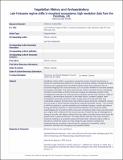Files in this item
Late Holocene regime shifts in moorland ecosystems : high-resolution data from the Pennines, UK
Item metadata
| dc.contributor.author | Davies, Althea | |
| dc.date.accessioned | 2016-08-11T23:32:55Z | |
| dc.date.available | 2016-08-11T23:32:55Z | |
| dc.date.issued | 2016-05 | |
| dc.identifier | 207294464 | |
| dc.identifier | 8138e82e-0ee8-4b14-9f70-e1f6cd54075f | |
| dc.identifier | 84938892238 | |
| dc.identifier | 000373747400001 | |
| dc.identifier.citation | Davies , A 2016 , ' Late Holocene regime shifts in moorland ecosystems : high-resolution data from the Pennines, UK ' , Vegetation History and Archaeobotany , vol. 25 , no. 3 , pp. 207-219 . https://doi.org/10.1007/s00334-015-0544-9 | en |
| dc.identifier.other | ORCID: /0000-0002-8982-7471/work/52888765 | |
| dc.identifier.uri | https://hdl.handle.net/10023/9287 | |
| dc.description | This research was funded by the Economic and Social Research Council through the Rural Economy and Land-Use Programme (RES-229-27-0003). | en |
| dc.description.abstract | Identifying critical shifts in ecosystems caused by human impacts has become a priority for understanding resilience to change and setting realistic management goals. Previous work suggests that many British blanket peats have suffered a loss of functional integrity over recent centuries, but it is unclear whether all moorland habitats are equally vulnerable. This study examines the relative sensitivity of four contrasting moorland communities to historic land-use changes and assesses whether these management pressures are pushing some moorlands beyond their Holocene range of variability. Late Holocene dynamics in the Peak District, northern England, were investigated using high-resolution pollen, fungal spore and charcoal data, and multivariate analyses. All sites show high Calluna values during the nineteenth century and converge on local Poaceae-dominance during the twentieth century. This involved a shift from gradual or cyclical variability and moderate changes in pollen abundance during preceding centuries, to rapid transitions between mono-dominant pollen assemblages and a functional shift to taxa with competitive traits; these are interpreted as a regime shift. Evidence for the recent recovery of dwarf-shrubs and Sphagnum is strong at one site, with slight evidence from two others, but disturbance could push the system back to grass-dominance. The deep blanket peat site may have crossed a threshold, leading to a persistent grass-dominated state. Studying regime shifts on decadal to centennial scales can help bridge the gap between ecology and palaeoecology by providing a robust basis for assessing vulnerability, setting restoration priorities and managing novel peatland states. | |
| dc.format.extent | 13 | |
| dc.format.extent | 4181732 | |
| dc.language.iso | eng | |
| dc.relation.ispartof | Vegetation History and Archaeobotany | en |
| dc.subject | Conservation | en |
| dc.subject | Dung fungi | en |
| dc.subject | Heathland | en |
| dc.subject | Peak District | en |
| dc.subject | Peatland | en |
| dc.subject | Pollen analysis | en |
| dc.subject | GE Environmental Sciences | en |
| dc.subject | NDAS | en |
| dc.subject | SDG 15 - Life on Land | en |
| dc.subject.lcc | GE | en |
| dc.title | Late Holocene regime shifts in moorland ecosystems : high-resolution data from the Pennines, UK | en |
| dc.type | Journal article | en |
| dc.contributor.institution | University of St Andrews. Geography & Sustainable Development | en |
| dc.identifier.doi | 10.1007/s00334-015-0544-9 | |
| dc.description.status | Peer reviewed | en |
| dc.date.embargoedUntil | 2016-08-11 | |
| dc.identifier.url | http://dx.doi.org/10.5255/UKDA-SN-6791-1 | en |
This item appears in the following Collection(s)
Items in the St Andrews Research Repository are protected by copyright, with all rights reserved, unless otherwise indicated.

